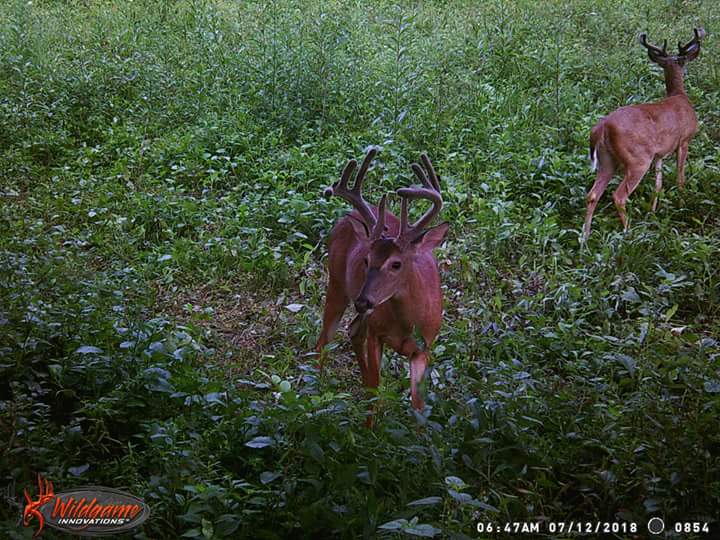There is a lot of speculation as to why so many big bucks are killed the first few days of season. Some hunters think it is because the deer have not been pressured for months by hunters. Others contribute their success to good scouting before the start of season.
A good number of big bucks are killed early in the season because of a combination of good scouting and the whitetails need to eat. Because of the pre-season scouting hunters did, they have a good idea where and what the deer are feeding on.
From the first day of deer season up until the beginning of the rut deer are eating. Early in the season whitetails are still in their summer patterns, spending a lot of their time out in the open eating. They search for the most nutritious food they can locate so they can put on fat for the long winter ahead.
It is like a sixth sense is telling does to eat now while the food is available and they have time to eat. Because, before long, bucks are going to be running the girls ragged once the rut begins. Bucks need to be eating now too. They will lose up to 30-percent of their body weight during the rut.
Whitetails do not just eat any old plants like some animals do. In fact, whitetails are picky about what they eat. They try to find food high in protein and eat all they can of it. Some of their favorite foods include corn, soybeans, cover, alfalfa, winter wheat, acorns, persimmons, apples, browse and the green brassica tops of beets and turnips.
After a couple frosts, the deer will feed on the sugar beets and turnip bulbs. This is when the bulbs will be the sweetest.
Bucks are normally still in bachelor groups when archery season opens, but this will not last for long. If you did your pre-season scouting from a distance using good optics and trail cameras you should have a good idea of what bucks are in the area.
Leading up to opening day, deer can be found in green soybeans that have not lost their moisture yet, clover, alfalfa, oats, and so on. These foods have been available all summer long and deer have grown accustomed to eating them. Unfortunately, not all areas that hold whitetails are agricultural lands. When this is the case, deer will turn to eating fresh leaves, plant tips and grasses.
Eventually, late summer/early fall will find mast like acorns on the ground. When the mast drops, deer will change their eating habits. Hard mast like acorns and beechnuts have a lot of fats and carbs which help build fat for the harsh winter to come.
Soft mast like persimmons, apples and pears are full of sugars that deer crave. Acorns are the preferred choice for deer above all else.
Because bucks are still somewhat predictable while they are still in their summer feeding routine it is easier than you might think to get set up on them. It is possible to have an opportunity at an unsuspecting buck early in the season because they have not been pressured for several months.
It doesn’t take long for a buck to begin to feel the pressure and change his patterns, so you had better kill him quick or it is going to get a lot tougher as the season progresses.
Early in the season hunter have to be careful, but an evening hunt early in the season when food sources like soybeans and early season food plots are being visited by several deer can pay off for the hunter. Often does will enter the field first and the bucks will join last when they feel the coast is clear.
Scent control and concealment is very important as you are likely to have does and fawns around you all evening. Locate staging areas 20-100 yards inside the cover. This is where you should be hunting, not on the edge of the food. This will give you a better opportunity to see the buck before is becomes too dark to shoot.
If you hunt on the fields edge, you might have a problem getting down when it is dark. If deer are still in the field and you climb down you have just educated the deer to your location. Plan an exit strategy in advance.
As I mentioned earlier, deer will change what they eat as mast falls to the ground. Deer will leave the fields to take advantage of the mast. This is where trail cameras are so handy. Hunters can use these cameras to keep of track of the changing diet of the whitetails and change their hunting tactics accordingly.
To be successful doing this, hunters need to know in advance which trees have mast. To prevent disrupting the animals, place the cameras on the trails leading to the trees rather than in the middle of them. Also, check the cameras every two or three days instead of every day.
Another good indicator the mast has fallen is the deer seem to have vanished from the fields overnight. Mast can disappear pretty fast so a hunter has to be prepared to move at moment’s notice when it begins to hit the ground.
Focusing on the food early in the season is a great opportunity to harvest a big buck. Does it equal the excitement and the unknown that comes with hunting the rut? Most times the answer is no. But in the end the goal is the same, to kill a nice buck legally and ethically.



















![The Best Deer Camp Chili [VIDEO] Deer Chili Ingredients, Tomatoes, Chili Spices](/wp-content/uploads/2015/10/Deer-Chili-Deer-Camp-Recipe-218x150.jpg)
![How to Call Elk Early in the Season [VIDEO]](/wp-content/uploads/2016/08/byers003-218x150.jpg)




![Idiots Disturb Hunter: How Would You Have Handled It? [VIDEO]](/wp-content/uploads/2015/10/DSC00110-e1474487693878-100x70.jpg)
![Albino Buck Shocked to Shed His Antlers [VIDEO]](/wp-content/uploads/2015/10/AlbinoDeer-100x70.jpg)